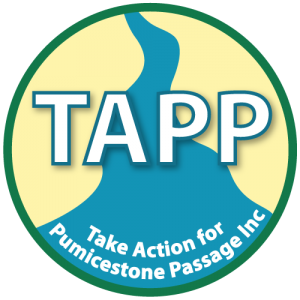Shannon Mooney, Healthy Land and Water
Team Leader, Science, Information and Monitoring
Over the last 15 years, Shannon has collated, developed and implemented a Corporate GIS System that underpins Healthy Land and Water’s business strategy and investment initiatives. This work has enabled and informed the South East Queensland Natural Resource Management Plan, Ecosystem Health Monitoring Program, Report Cards, SEQ Atlas and numerous decision support tools.
Shannon has been involved in a suite of Biodiversity and Nature Conservation Programs including the Qld Fire and Biodiversity Consortium, SEQ Land for Wildlife, SEQ Rainforest Recovery, SEQ Koala Advisory Council and Koala Arks, Moreton Bay Ramsar, and various state and local biodiversity planning and policy initiatives. I look forward to sharing some of the work Healthy Land and Water is involved in to better understand the biodiversity values of the Pumicestone Region.
Abstract:
The Pumicestone Passage has many outstanding ecological values and is also recognised internationally as a wetland of importance under the Ramsar Convention. However, land use change and population growth are adding increasing pressure on the biodiversity values of the region. Recent fires and coastal erosion are ongoing threats requiring new and ‘old’ approaches. Ongoing management efforts are needed to conserve and restore this important area. Areas with national and state environmental significance in the Pumicestone Region include wader habitat, threatened species and wildlife habitats, wetlands, saltmarsh and lowland rainforest endangered ecological communities, and vulnerable and poorly conserved forests.
Maintaining connected, healthy habitat and waterways is essential to sustaining the biodiversity and ecological significance of the region. The extent and condition of core and connected forests across the Pumicestone provides ecological networks within the coastal and estuarine environment to the uplands via waterway and riparian forests connecting with D’Aguilar and Blackall Ranges linkages. The Pumicestone Passage Marine Park is also part of a series of global marine sites considered critical to the health of the world’s oceans.
Over 10,000 high precision records of rare and threatened species have been recorded for the area. Some significant species include the Australian lungfish, Macadamia sp., Christmas bells, dugong, eastern curlew, glossy black-cockatoo, koala, long-nosed potoroo, platypus, powerful owl, Richmond birdwing butterfly, southern greater glider, and the spotted-tailed quoll.
Healthy Land and Water and its partners are leading many strategic initiatives to halt or reverse the decline in natural asset condition across the Pumicestone Region. It is also undertaking a major review of the South East Queensland Natural Resource Management Plan, which includes assessing and updating progress against targets set out in the plan. This includes review of the coastal and nature conservation assets. Anyone interested in being part of the NRM Plan review is invited to get involved during the engagement process, which begins on Day 3 of this conference.
